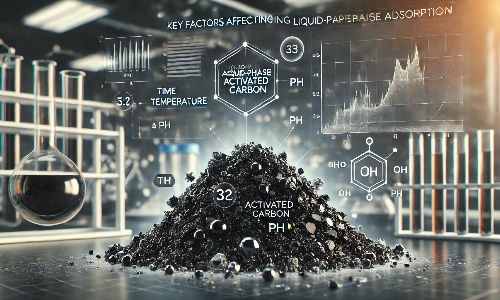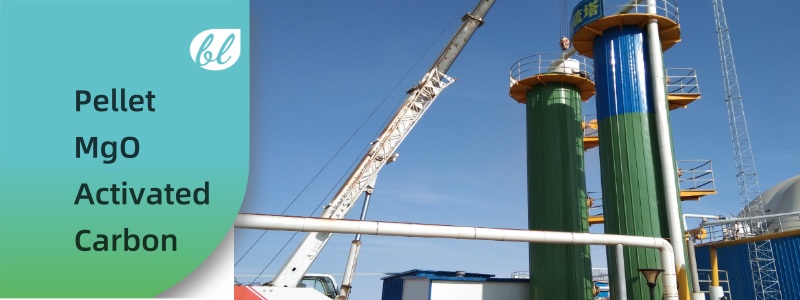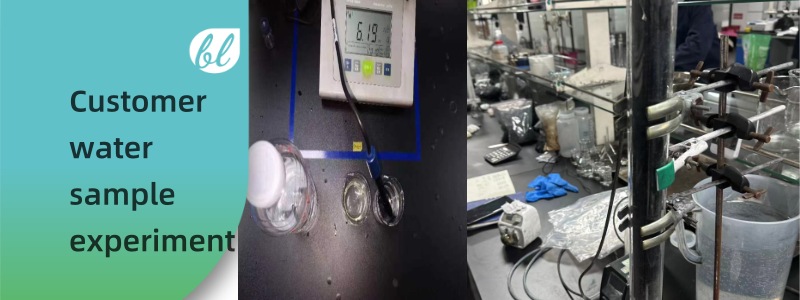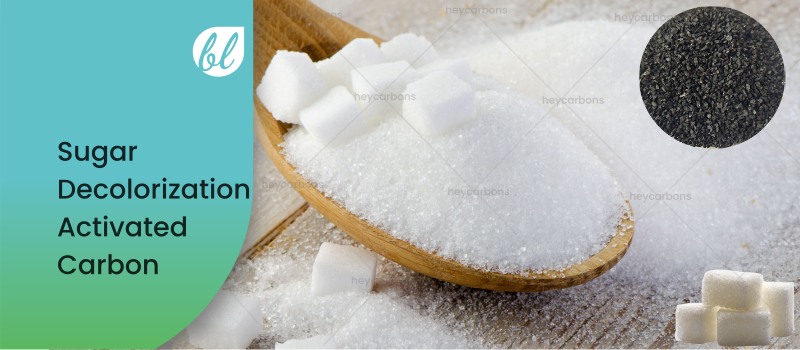Activated carbon is a kind of microcrystalline carbon material mainly made of carbon-containing materials with black appearance, well-developed internal pore structure, large specific surface area, and strong adsorption and decolorization ability. It is widely used in water treatment, air purification, medicine, food, chemical industry and other fields. Its performance can be measured by multiple key parameters. Different application scenarios have different requirements for these parameters.
The following are several important indicators of activated carbon and their definitions.
1.Iodine value
Iodine value definition of activated carbon: Iodine value refers to the ability of activated carbon to adsorb iodine, iodine value unit is in mg/g. The relative molecular mass of iodine (I₂) is 253.8. The higher the iodine value, the more similar pores of the activated carbon, the larger the specific surface area and the stronger the adsorption capacity. The higher the iodine value, the higher the adsorption capacity of activated carbon.
Iodine value is often used in water treatment and air purification applications and is the primary indicator of activated carbon’s adsorption of small molecular organic matter. Generally speaking, activated carbon with high iodine value is more effective in purifying small molecular organic pollutants and gaseous harmful substances in water.
In liquid phase applications, such as drinking water purification, industrial wastewater treatment, and food and beverage filtration, activated carbon with a higher iodine value usually has a rich microporous structure and can effectively remove small molecular organic pollutants in water. These small molecules can easily enter into the microporous structure and be adsorbed. The higher the iodine number for activated carbon, the more it can adsorb the impurities in the solution.
The iodine value of activated carbon for liquid phase adsorption is at least 800 mg/g, while for more demanding applications the iodine value may reach 1700 mg/g. This kind of activated carbon is mainly used in ultra-pure water systems in the semiconductor industry, POE and POU water treatment, water treatment in the beer and beverage industries, and water treatment in the food industry.
Testing standards for iodine value: ASTM D4607-2014,GB/T 12496.8-2015 for wood activated carbon, GB/T 7702.7-2008 for coal-based activated carbon.
Inquire now! We can send you a free brochure with product information.
2.PH
The activated carbon pH is mainly affected by its production method and the raw materials used. For example, coal-based activated carbon is usually alkaline and has a high pH, while coconut shell-based activated carbon is closer to neutral.
If the original pH of the activated carbon does not meet the requirements, it can be adjusted by chemical treatment. We can treat the activated carbon with acid to lower its pH or with alkali to increase its alkalinity. This conditioning technology is widely used in the water treatment and air purification industries to ensure that the performance of the activated carbon can meet the specific requirements of the application.
The effect of pH on adsorption is significant, and selecting appropriate pH conditions can significantly improve the removal efficiency of activated carbon for specific pollutants or ions. In practice, it is often necessary to adjust the pH according to the characteristics of the target adsorbent to achieve optimal adsorption.
Generally speaking, the activated charcoal pH of untreated wood powdered activated carbon is between 2-4, showing a certain degree of acidity. We can adjust the pH value to 3-5,4-7,5-8.
The pH value of coal-based activated carbon is usually 9-12, through alkaline solution soaking treatment. The pH value can be adjusted to 7-9 by acid washing.
The pH value of coconut shell activated carbon is generally 8-10. After acid washing and water washing, the pH value can be adjusted to 7-9.
Testing standards for pH: ASTM D3838-2005(2011), GB/T 12496.7-1999 for wood activated carbon, GB/T 7702.16-21997 for coal-based activated carbon.
3.Methylene blue
Methylene blue indicates the adsorption capacity of activated carbon for molecules of methylene blue dye, and is mainly used to measure the adsorption effect of activated carbon on medium molecular weight organic matter. It reflects the maximum mass or volume of methylene blue dye that can be adsorbed by each gram of activated carbon under standard test conditions. Common units are mg/g and ml/0.1g. The unit conversion formula: 1ml/0.1g = 15mg/g, such as 8ml/0.1g = 120mg/g.
Methylene blue (C₁₆H₁₈ClN₃S) has a relative molecular mass of 319.85. Its molecular diameter is larger than the molecular diameter of iodine. Methylene blue value is usually used to indicate the number of activated carbon pore. The higher the value, the stronger capacity adsorption of methylene blue on activated carbon.
Activated carbon with high methylene blue value is usually suitable for wastewater treatment, industry and food decolorization. It’s often used to remove dyes and other organic pollutants in solution. In practical applications, the methylene blue value is often used to represent the decolorization ability of activated carbon. The higher the methylene blue value, the better the decolorization performance under the same unit weight.
For activated carbon of different raw materials, generally wood powder activated carbon and wood granular activated carbon have the highest methylene blue. The others are ordered from large to small: peach shell, apricot shell, coal, coconut shell.
Testing standards for methylene blue: GB/T 12496.10-1999 for wood activated carbon, GB/T 7702.6 for coal-based activated carbon.
Inquire now! We can send you a free brochure with product information.
4.Specific surface area
Specific surface area refers to the total surface area per unit mass of activated carbon, usually expressed in square meters per gram (m²/g). The larger the specific surface area, the more porous and the higher adsorption capacity the activated carbon has.
The specific surface area measurement is usually by the BET method, which reflects the combined surface area of the micropores, mesopores and macropores of the activated carbon. The specific surface area of activated carbon is usually 500~1000 m²/g, which is the basis of its adsorption capacity.
The specific surface area of activated charcoal is usually 300-1500 m²/g, depending on its preparation method and the type of raw materials. Due to the pore structure and surface characteristics of activated charcoal, this high specific surface area makes it perform well in gas and liquid adsorption and is widely used in water treatment, air purification and chemical separation.
The high surface area activated carbon is suitable for fields such as water treatment, air purification, medicine and food, where product purity is required to be relatively high.
Testing standards for specific surface area: GB/T 7702.20-2008 for coal-based activated carbon.
5.Ash
Ash refers to the content of inorganic components in activated carbon, expressed as mass percentage, mainly the minerals remaining after the raw materials are carbonized and activated. In general, the lower the ash content in activated carbon, the higher the purity and the better its adsorption performance.
The presence of ash occupies the pore space of the activated carbon and reduces the adsorption capacity, so low ash content is particularly important for the production of high-quality activated carbon.
How to reduce the activated carbon ash content? We can achieve it through the following measures:
- Select raw materials with low ash content: The ash content of different raw materials is different. Therefore, choosing raw materials with lower ash content is the primary method to control ash content.
- Pretreatment: Pretreatment of raw materials before activation, such as water washing or acid washing, can effectively remove some minerals and reduce ash (This method is more expensive and usually less used. This is usually taken after activation).
- Optimize activation process: During the activation process, the generation of ash in the raw materials can be reduced by strictly controlling the amount of activator, activation temperature and time.
- Retreatment: After activation, washing or other forms of chemical treatment of the activated carbon can further remove residual activation substances and reduce ash content.
- Through repeated activation and retreatment, the ash is gradually removed and the adsorption capacity of activated carbon is improved.
Effects of ash in use:
- In practical applications, ash will occupy part of the pore structure of activated carbon, especially micropores and mesopores, thereby reducing the effective specific surface area available for adsorption and reducing the adsorption performance.
- Ash may also react chemically with certain pollutants, changing the surface properties of the activated carbon and affecting the selectivity of adsorption for specific pollutants.
- Metal oxides in the ash may react chemically in an oxidative or acidic environment, resulting in a decrease in the chemical stability of the activated carbon.
Testing standards for ash: ASTM D2866-2011, GB/T 12496.3-1999 for wood activated carbon, GB/T 7702.15-2008 for coal-based activated carbon.
6.Heavy metal
In the field of activated carbon, heavy metal content refers to the trace metal elements contained in activated carbon, such as lead, cadmium, mercury and chromium. These heavy metals originate from the raw materials of activated carbon or impurities introduced during the production process.
Heavy metal content is an important indicator for evaluating the safety and applicability of activated carbon in specific fields such as water treatment, food and medicine. The heavy metal content in activated carbon of high quality needs to be controlled at a very low range to avoid pollution and potential health hazards.
Heavy metals in activated carbon may come from the following aspects:
- Natural impurities in raw materials: Natural materials such as coal, coconut shells and wood contain trace amounts of minerals and metal ions that may remain during the activation process.
- Impurities introduced by production equipment or processing: Production processes and chemical treatments may leave a small amount of metal elements in the activated carbon, especially during chemical activation and catalyst use.
- Contaminants: Heavy metals may be introduced by contaminants to which the activated carbon is exposed during production or storage.
Without special treatment, the heavy metal content of activated carbon from different raw materials is arranged from small to large: coconut shell, fruit shell, wood, coal.
Activated carbon heavy metal removal is very important in production. We can reduce heavy metal content by:
- Give priority to using natural materials with low heavy metal content, such as coconut shells or certain types of coal.
- Acid washing after activation can remove part of the residual metal ions.
- Ensure that no additional metal contaminants are introduced during the production process and that clean equipment and processing conditions are used.
Testing standards for heavy metal: GB/T 12496.22-1999 for wood activated carbon.
Inquire now! We can send you a free brochure with product information.
7.CTC
CTC refers to the adsorption capacity of activated carbon for carbon tetrachloride, and is an important indicator to measure the adsorption capacity of activated carbon for macromolecular organic matter.
The relative molecular mass of carbon tetrachloride (CCl₄) is 153.8, and it consists of one carbon atom and four chlorine atoms. The CTC value indicates the mass of carbon tetrachloride that can be adsorbed by activated carbon per unit weight, usually expressed as a percentage. For example, a CTC value of 60% means that 1g of activated carbon can adsorb 0.6g of carbon tetrachloride. The higher the activated carbon CTC, the stronger the adsorption capacity.
Methods to improve the CTC value include selecting high-quality raw materials, optimizing the activation process, and chemically treating the surface of activated carbon.
CTC is mainly used to evaluate the gas phase adsorption capacity of activated carbon and is the main test method for quality control of gas phase carbon.
Testing standards for CTC: ASTM D3467, GB/T12496.5-1999 for wood activated carbon, GB/T 7702.13-1997 for coal-based activated carbon.
8.Molasses value
The molasses value (or molasses number) refers to the decolorization ability of activated carbon on molasses solution, which reflects the ability of activated carbon to adsorb pollutants. Molasses contains a wide variety of sugars and other complex macromolecules and generally has the highest average molecular weight. The higher molasses value indicates that the activated carbon has more mesoporous structure and stronger adsorption capacity, which is suitable for removing macromolecular organic matter.
A higher molasses number activated carbon has more mesopores and is suitable for treating solutions containing larger molecular weight pollutants, such as removing colored substances and odor molecules from water.
Molasses values have a wide range of applications in industrial wastewater treatment, beverage filtration and waste gas purification. Especially in removing dyes, pigments and other macromolecular organic pollutants from industrial wastewater, activated carbon with high molasses value can provide more efficient decolorization and purification effects. For example, the food and beverage industry often use activated carbon with a high molasses value to remove undesirable pigments and odors to ensure the purity and taste of the product.
9.Strength
Strength refers to the ability of activated carbon to resist crushing or pulverization under external forces (such as compression, impact or friction). It is a key physical parameter for the stable operation of activated carbon in various application environments. High hardness activated carbon excels in maintaining particle integrity and can maintain good adsorption performance over long periods of time and under high mobility conditions.
The strength of activated carbon is mainly derived from the density of the material itself and the activation process. Common strength testing methods include crushing test and abrasion test, which are used to simulate the conditions under which they will be used in actual operations. Typically, coconut shell-based activated carbon has better strength performance due to its dense microporous structure and high mechanical strength, making it suitable for applications with high strength requirements.
For different forms of activated carbon, the strength is arranged from large to small: columnar activated carbon, granular activated carbon, powdered activated carbon. For activated carbon with different raw materials, the strength is arranged from large to small: coconut shell, fruit shell, coal, wood.
Testing standards for strength: ASTM D3802-10, GB/T 12496.6 for wood activated carbon, GB/T 7702.3-2008 for coal-based activated carbon.
Inquire now! We can send you a free brochure with product information.






